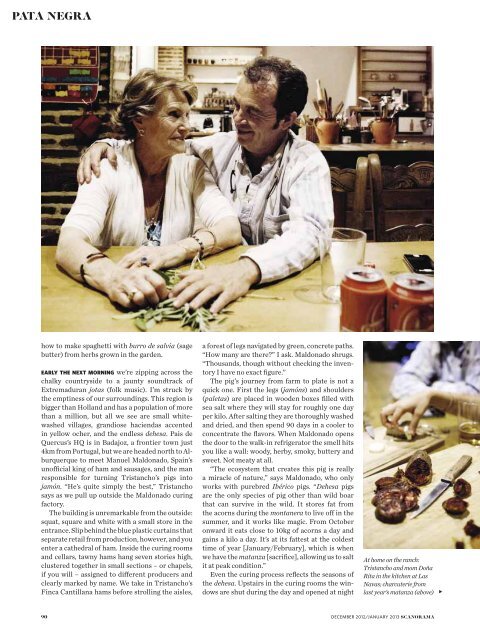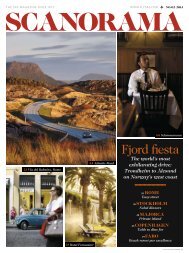You also want an ePaper? Increase the reach of your titles
YUMPU automatically turns print PDFs into web optimized ePapers that Google loves.
PATA NEGRA<br />
how to make spaghetti with burro de salvia (sage<br />
butter) from herbs grown in the garden.<br />
EARLY THE NEXT MORNING we’re zipping across the<br />
chalky countryside to a jaunty soundtrack of<br />
Ex tre maduran jotas (folk music). I’m struck by<br />
the emptiness of our surroundings. This region is<br />
bigger than Holland and has a population of more<br />
than a million, but all we see are small whitewashed<br />
villages, grandiose haciendas accented<br />
in yellow ocher, and the endless dehesa. Pais de<br />
Quercus’s HQ is in Badajoz, a frontier town just<br />
4km from Portugal, but we are headed north to Alburquerque<br />
to meet Manuel Maldonado, Spain’s<br />
unofficial king of ham and sausages, and the man<br />
responsible for turning Tristancho’s pigs into<br />
jamón. “He’s quite simply the best,” Tristancho<br />
says as we pull up outside the Maldonado curing<br />
factory.<br />
The building is unremarkable from the outside:<br />
squat, square and white with a small store in the<br />
entrance. Slip behind the blue plastic curtains that<br />
separate re tail from production, however, and you<br />
enter a ca thedral of ham. Inside the curing rooms<br />
and cellars, tawny hams hang seven stories high,<br />
clustered together in small sections – or chapels,<br />
if you will – assigned to different producers and<br />
clearly marked by name. We take in Tristancho’s<br />
Finca Cantillana hams before strolling the aisles,<br />
a forest of legs navigated by green, concrete paths.<br />
“How many are there?” I ask. Maldo nado shrugs.<br />
“Thousands, though without checking the inventory<br />
I have no exact figure.”<br />
The pig’s journey from farm to plate is not a<br />
quick one. First the legs (jamóns) and shoulders<br />
(paletas) are placed in wooden boxes filled with<br />
sea salt where they will stay for roughly one day<br />
per kilo. After salting they are thoroughly washed<br />
and dried, and then spend 90 days in a cooler to<br />
concentrate the flavors. When Maldonado opens<br />
the door to the walk-in refrigerator the smell hits<br />
you like a wall: woody, herby, smoky, buttery and<br />
sweet. Not meaty at all.<br />
“The ecosystem that creates this pig is really<br />
a miracle of nature,” says Maldonado, who only<br />
works with purebred Ibérico pigs. “Dehesa pigs<br />
are the only species of pig other than wild boar<br />
that can survive in the wild. It stores fat from<br />
the acorns during the montanera to live off in the<br />
summer, and it works like magic. From October<br />
onward it eats close to 10kg of acorns a day and<br />
gains a kilo a day. It’s at its fattest at the coldest<br />
time of year [January/February], which is when<br />
we have the matanza [sacrifice], allowing us to salt<br />
it at peak condition.”<br />
Even the curing process reflects the seasons of<br />
the dehesa. Upstairs in the curing rooms the windows<br />
are shut during the day and opened at night<br />
At home on the ranch:<br />
Tristancho and mom Doña<br />
Rita in the kitchen at Las<br />
Navas; charcuterie from<br />
last year’s matanza (above) �<br />
90 DECEMBER 2012/JANUARY 2013 SCANORAMA












